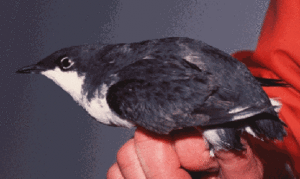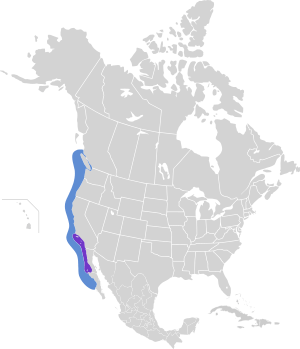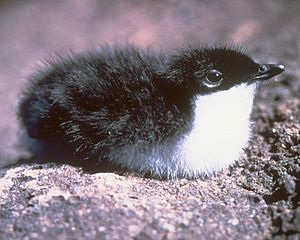Scripps's murrelet facts for kids
Quick facts for kids Scripps's murrelet |
|
|---|---|
 |
|
| Conservation status | |
| Scientific classification | |
 |
|
| Synonyms | |
|
Synthliboramphus hypoleucus scrippsi |
The Scripps's murrelet (Synthliboramphus scrippsi) is a small seabird. It lives in the Pacific Ocean near California and Mexico. This bird is a type of auk. It builds its nests on islands.
Sadly, Scripps's murrelets face dangers. New animals brought to their islands can hunt them. Also, oil spills in the ocean are a big threat.
Before 2012, this bird was known as Xantus's murrelet. It was thought to be the same species as the Guadalupe murrelet. But scientists found they were different. They don't breed together. They also look a bit different and sound different. Their genes are also not the same. So now they are two separate species.
Contents
What Does a Scripps's Murrelet Look Like?
This bird is small. It has black and white feathers. It has a small head and a thin, sharp beak. It looks a lot like the Craveri's murrelet. Both of these birds live further south than any other auk species.
Scripps's murrelets make their nests on islands. These islands are part of the Channel Islands of California. Many birds nest on the Coronado Islands and Santa Barbara Island. They also nest on islands near Baja California, like Isla Guadalupe.
After they finish nesting, they fly north. They travel as far as British Columbia in Canada. They usually stay out at sea during this time.
How Do Scripps's Murrelets Live?
Scripps's murrelets find their food in the ocean. They often feed near large fish like tuna. These big fish help them find smaller fish. They eat tiny fish like anchovies, sardines, and rockfish.
Like all auks, they dive underwater to catch food. They use their wings to swim fast. They flap their wings to chase fish. Scientists think they might hunt in pairs. This is because they are almost always seen in pairs. This happens even when it's not nesting season. They are also good at flying. They can take off from the water very quickly.
These birds build their nests in loose groups. They choose dry islands. They often nest in small cracks, caves, or under thick bushes. They only come to the nesting area at night. This helps them stay safe from predators.
A female murrelet lays two eggs. The parents sit on the eggs for about a month. When the chicks hatch, they are very active. They leave the nest within two days! They run towards the sea. Their parents call to them from the water. Once the family is in the ocean, they swim to deeper waters.
Scientists don't know much about their lives at sea. It is hard to study them there.
Protecting Scripps's Murrelets
At one point, Scripps's murrelets were thought to be very endangered. Other auk species have become rarer since then. But the Scripps's murrelet still needs our help.
One big danger is oil spills. Many murrelets live near busy shipping lanes. These lanes connect Los Angeles to other ports. If a large oil spill happens, it could harm many birds. A single big spill could affect a huge part of their small population.
Another threat comes from introduced species. These are animals like rats and feral cats. They are brought to the islands by people. These animals hunt the murrelet eggs and chicks.
Good news! People are working to protect these birds. They are removing the animals that hunt them. For example, in 2001 and 2002, groups worked together. They removed invasive rats from Anacapa Island. This project was paid for by money from an oil spill cleanup.
See also
 In Spanish: Mérgulo de Scripps para niños
In Spanish: Mérgulo de Scripps para niños



